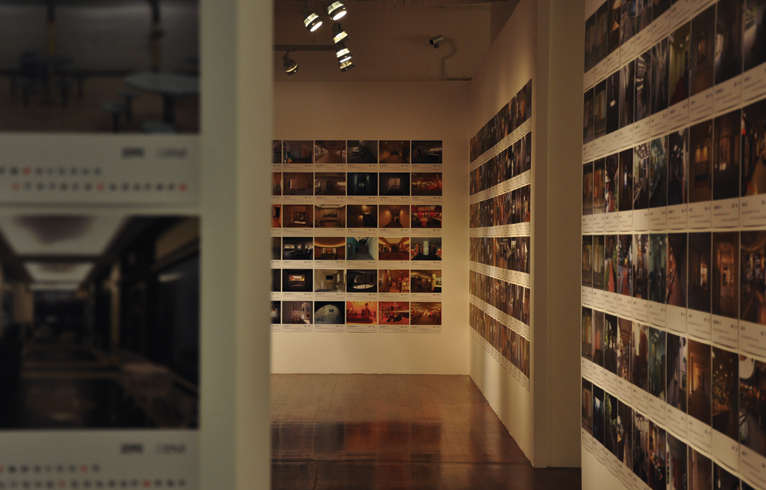HEMAN CHONG: CALENDARS (2020-2096)
| May 29, 2012 | Post In LEAP 14

Heman Chong’s practice, concisely stated on his website, “… involves an investigation into the philosophies, reasons and methods of individuals and communities imagining the future.” Presented at the NUS museum in Singapore, “Calendars (2020-2096)” is a full embodiment of this credo. Consisting of 1,001 color images of public interior spaces in Singapore he visited over a span of seven years, this archival aim is not only to preserve memories of sites Chong has forged relationships with, but also to generate a “dream machine” that postulates a framework that may extend to a dialogue on something much larger.
For his “Stack” series (2003-2010)— sculptures composed annually of books read by the artist with drinking glasses or perfume bottles from the same period— the artist adopted a seemingly passive method of “recommending” alternate readings of the world. “Calendars (2020-2096)” expands outward from this method, and adds an empathetic spin as a point of entry. Standing in front of these images of public interiors, effaced as they are of human presence, viewers may identify with the visual elements of these environs, and compartmentalize and deconstruct these elements towards conjuring their emotions, knowledge, and imaginings. Moreover, it extends from a casual compilation of objects that have influenced the artist— an inward focus on the identity of the individual— to an indexical compilation of architectural elements— an outward focus on the identity of a larger community.
Categorized into corridors, shop fronts, depots, banquet halls, IKEA, the airport, eateries, and so on, these images reveal a spectrum of spatial and architectural lexicons specific to the landscape of Singapore, that modern technocratic construct shuffled through waves of political change and capital. From Socialist-style residences to the landmark of Marina Sand Bay and underlined by the various pockets of ethnicity tucked behind its coastal skyscrapers, this construct is a representation of different values and styles of the times. Chong may not have managed such large-scale preservation, yet in this, the mother ship of his artistic practice over seven years, the artist retreats, observes and reflects on his surroundings, ultimately extrapolating and deconstructing the meanings that embody his identity. Bringing these into the alcove of a museum, Chong invites his audience for a meditative moment with his subjectivity, in order to imagine their own.
The concept behind “Calendars (2020-2096)” straddles not only the notion of space, but also that of temporality. Distributing 1,001 images over a future of 77 years and deconstructing the similarities among the elements in each image suggests an elasticity of time. The visual experience of looking at them confuses the sense of time as a linear progression; only in reading the future date, month, and year marked under each image is one reminded of the present.
Dating the project from 2020 satirically sets the tone for this sci-fi epic, where you, the viewer, now a protagonist to this open-ended story, are the “last man standing.” Resonating with Kurt Vonnegut’s last rule of writing fiction, Chong has given his viewers as much information as possible and at the earliest possible time, so that they may complete the story of their own accord. These images give way to staccatos of synopsis, transgressing Chong’s misanthropic dystopia. The bleak doomsday scenario with which you are confronted may seem surreal, oozing with solitude. Should you defy it and seek the truth, either natural or artificial, the light source on every image may be read as a glimpse of hope.
It would be much simpler, however, to delve into the past for excuses, or to react against the present. Chong’s approach is to propose an alternative— perhaps proactive, at times hysterical, but definitely not solipsistic— for viewing the world in its future. Urging speculations about the unknown but based on the past and present, it is an alternative that incurs experimentation, one that may shed light on the conditions at hand. Fiona He

